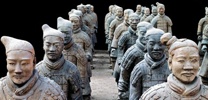Neil MacGregor, Director of the British Museum, writes in The Times about the terracotta warriors from Qin Shi Huangdi’s mausoleum, which will be displayed next month at his museum, in the largest exhibition of objects from the tomb complex ever to travel abroad:
It is now more than 30 years since a peasant digging a well in northwestern China unexpectedly came across some fragments of fired clay, triggering the greatest archeological discovery of the 20th century – the terracotta army guarding the tomb of China’s First Emperor. The soldiers quickly became international celebrities, travelling in twos and threes to exhibitions across the world. Since 1974, excavation of the tomb has continued steadily. Slowly – infuriatingly slowly for an impatient world – a huge underground complex began to emerge. This was not just an army for the afterlife, but a parallel kingdom. While the work will carry on for decades, every few years to date have yielded major discoveries. And at each step, our assumptions about the scale of the emperor’s ambitions have had to be revised, as the warriors have been joined by more and more departments of the vast subterranean imperial household. [Full text]








